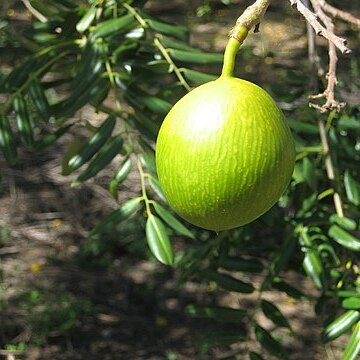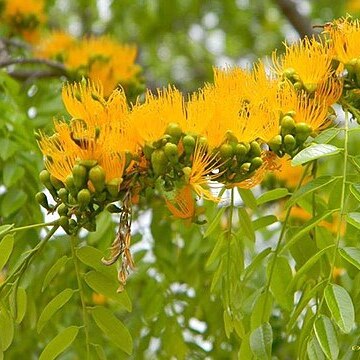Tree 9–24(?–40) m. high; bark brown or grey, rough, much fissured; crown bushy.. Leaves: petiole with rhachis (5–)9–24 cm. long; leaflets 11–28, oblong, oblong-elliptic or ovate-oblong, (1–)2–5 cm. long, (0.7–)1.2–2.4 cm. wide, rounded at apex and sometimes slightly emarginate, rounded at base, minutely appressed-puberulous beneath.. Racemes usually borne on shoots of current season below the leaves, 1.5–11 cm. long; pedicels (and outside of receptacle and calyx) subglabrous to shortly and finely pubescent, 4–9 mm. long.. Flowers (including stamens and ovary) 1.5–2.2(–3) cm. long.. Receptacle and calyx-lobes green, latter with tuft of yellowish pubescence at tip.. Stamens 23–45, orange-yellow.. Fruits ellipsoid, oblong or spherical, ± oblique, 4.5–8 cm. long, 3–6 cm. wide, yellow, 1–3-seeded.. Fig. 51, p. 222.
Medium to large tree to 23 m with a deciduous, almost flat, spreading crown. Bark: greyish-brown and rough in old trees. Leaves: compound; 11-28 alternate pairs of leaflets, with one at point of leaf axis; leaflets elliptic to oblong (20-40 x 10-20 mm); tip and base rounded, hairless, or minutely hairy below, pellucid glands and streaks visible, leaflets with 2-3 mm long petiolules, leaf axis up to 320 mm long, including petiole. Flowers: produced below the leaves in tight orange-yellow clusters; petals absent, stamens numerous and attractive, up to 25 mm long (Aug-Oct). Seeds produced in large oval pods (40-80 x 30-60 mm); yellow when ripe, seeds buried in an edible fleshy pulp (Dec-Feb).
It is a large tree. It grows up to 22 m tall. The trunk can be 1.2 m across. The branches spread widely. The bark is greyish brown and has furrows along it. The leaves are divided once. They are 25 cm long with about 9-12 pairs of leaflets with one at the end. The leaflets are 2.5-4 cm long. They are dark green and smooth. There are dots which let light through scattered over the leaf surface. The flowers occur in small sprays in the axils of leaves. The flowers face upwards and are filled with nectar. The fruit is a yellow fleshy succulent fruit. It is about 4 cm long and oval. It has a leathery skin and 1-8 seeds inside. The seeds are embedded in the sticky flesh. The fruit are edible.
Leaves: petiole and rachis together (5)9–24 cm long; leaflets 11–30, each (1)2–4(5) × (0.6)1–1.8(2.4) cm, oblong or oblong-elliptic or oblong-ovate, rounded to emarginate at the apex, rounded to truncate at the base, glabrous above, minutely appressed-pubescent beneath; petiolules up to 4 mm long.
Unarmed, deciduous tree, up to 23 m high. Leaves imparipinnate; leaflets 11-28, alternate, oblong, (10-)20-40 x (7-) 10-20 mm. Fruit ellipsoid, oblong or spherical, 30-80 x 20-60 mm, yellow when ripe. Flowers bright yellow.
Racemes usually borne in clusters on shoots of current season below the leaves, 1.5–6(11) cm long, appressed-pubescent; pedicels 3–4 mm long.
Usually a large deciduous tree up to 20(25) m high with a spreading crown; bark brown or grey, longitudinally fissured.
Seeds embedded in yellow sticky flesh, 1–4, c.3 × 1.5–1.8 cm, oblong.
Fruits up to 8 × 6 cm, the stipe c.2 cm long, ripening yellow.
Stamens 23–45, 13–21 mm long, yellow or orange-yellow.
Young branches glabrous or minutely pubescent.
Hypanthium 5–6 mm long, green.



